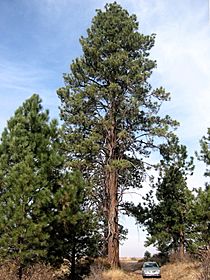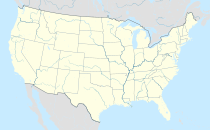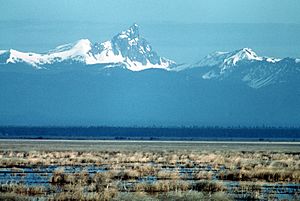Klamath Basin National Wildlife Refuge Complex facts for kids
Quick facts for kids Klamath Basin National Wildlife Refuge Complex |
|
|---|---|
|
IUCN Category IV (Habitat/Species Management Area)
|
|

Ponderosa Pine, Klamath Marsh
|
|
| Location | Oregon and California, United States |
| Nearest city | Klamath Falls, OR |
| Area | 192,000 acres (780 km2) |
| Established | 1908 |
| Governing body | United States Fish and Wildlife Service |
The Klamath Basin National Wildlife Refuge Complex is a special area in southern Oregon and northern California. It's a place where wild animals are protected. The United States Fish and Wildlife Service takes care of it.
This complex is made up of six different wildlife refuges. A refuge is like a safe home for animals. These refuges are:
- Bear Valley
- Klamath Marsh
- Upper Klamath (all in Oregon)
- Lower Klamath
- Tule Lake
- Clear Lake (all in California)
What are these Refuges?
These refuges protect many different kinds of habitats. Habitats are the natural homes of animals. Here you can find:
- Freshwater marshes (wetlands with lots of water plants)
- Open water (lakes and ponds)
- Grassy meadows
- Forests with tall trees like ponderosa pine
- Sagebrush and juniper grasslands
- Farm fields
- Rocky cliffs
These different habitats mean that many types of animals can live here. Over 430 different kinds of animals have been seen in or near these refuges!
A Look at Each Refuge
Each refuge has its own special features:
Lower Klamath National Wildlife Refuge
This refuge was created in 1908. It was the first waterfowl refuge in the entire United States! It covers about 46,900 acres (about 190 square kilometers). It has marshes, open water, and grassy areas. These areas are carefully managed to provide food, rest, and nesting spots for ducks, geese, and other water birds.
Clear Lake National Wildlife Refuge
Established in 1911, this refuge is about 46,460 acres (188 square kilometers). A big part of it, about 20,000 acres, is open water. The rest is dry land with grass, sagebrush, and juniper trees.
Upper Klamath National Wildlife Refuge
This refuge started in 1928. It's about 15,000 acres (61 square kilometers). Most of it is freshwater marsh and open water.
Tule Lake National Wildlife Refuge
Also established in 1928, Tule Lake covers about 39,116 acres (158 square kilometers). It has a lot of open water and farm fields.
Klamath Marsh National Wildlife Refuge
Created in 1958, this refuge is about 40,646 acres (164 square kilometers). It's mostly freshwater marsh and nearby meadows.
Bear Valley National Wildlife Refuge
This refuge was established in 1978. It's smaller, about 4,200 acres (17 square kilometers). Its main job is to protect a very important place where bald eagles sleep at night during the winter. It has old forests with large ponderosa pine, incense-cedar, white fir, and Douglas-fir trees.
Why are these Refuges Important?
The Klamath Basin is a super important stop for birds that migrate. Migrating birds fly long distances between their summer and winter homes. The Klamath Basin is like a major highway rest stop for them.
About three-quarters of all the waterfowl (ducks, geese, swans) that use the Pacific Flyway stop here. The Pacific Flyway is a major bird migration route in North America. At its busiest, over 1 million birds can be in the Klamath Refuges at one time! Because of this, the Klamath Refuge is called "the heartbeat of the Pacific Flyway."
Protecting the Wetlands
A long time ago, the Klamath Basin had huge areas of shallow lakes and freshwater marshes. There were about 185,000 acres (749 square kilometers) of these wetlands. Millions of waterfowl and other water birds like pelicans and herons lived there.
But in 1905, a big project started. It was called the Klamath Reclamation Project. Its goal was to turn some of these lakes and marshes into farmland. So, many wetlands were drained and became farms. Today, less than 25% of the original wetlands are left.
That's why these six National Wildlife Refuges are so important. They help save the wetlands that are still here. The U.S. Fish and Wildlife Service works hard to manage these refuges. They make sure there's enough water and good habitats for the wildlife. They also work with farmers to balance wildlife needs with farming.
Units include



